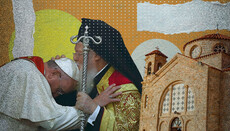Filaret as the main enemy of Ukrainian autocephaly
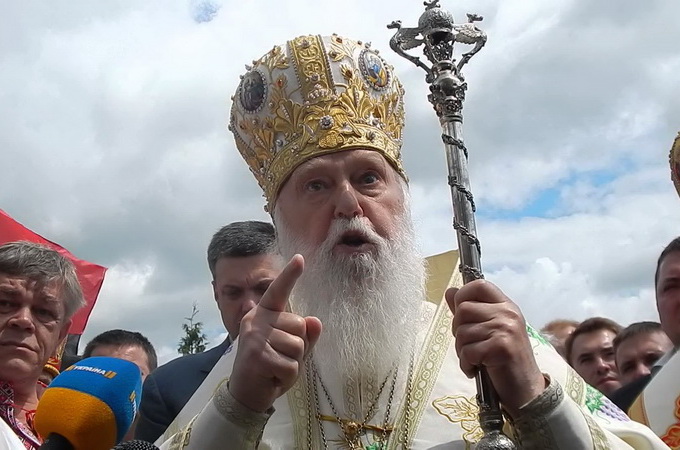
As soon as the Soviet Union collapsed in 1991 and the independent state of Ukraine appeared, the idea of creating an independent Church on its territory immediately arose. The idea is not new. Greece, Bulgaria, Serbia and other countries, freed from the oppression of the Ottoman Empire, implemented this idea in practice. Yes, their actions were uncanonical. Yes, for several decades they were in a state of excommunication from church unity. Yes, they passed the period of non-recognition, but in the end we now have canonical, recognized Local Churches: Greek, Bulgarian, Serbian, etc.
If not for citizen Denisenko, with a certain degree of probability it would be possible to assume that today there would exist in Ukraine a canonical autocephalous UOC headed by a patriarch recognized by the Universal Orthodoxy. And most likely, this obtaining autocephalous status would have taken place in a canonical way, with the consent of the Russian Orthodox Church.
There are two grounds for this assumption. First, it is a precedent for the painless granting of autocephaly to the Orthodox Church in America by the ROC in 1970. And secondly, it is the general political ideology of the early 1990s in the post-Soviet space: democracy, liberalization, the proclamation of all freedoms and independence. What was expressed by Boris Yeltsin in famous words, "Take as much sovereignty as you can carry." This general political mood was projected, albeit to a lesser extent, on church affairs. In addition, an indicative fact is that at the end of the 1980s, 25 out of the 77 bishops of the ROC (including 14 from Western Ukraine), who headed not only the Ukrainian dioceses, come from Ukraine.
The Ukrainian Orthodox Church received today's autonomous status with amazing ease. The appeal for autonomy was adopted by the Synod of the Ukrainian Exarchate on July 10, 1990. Just ten days later, on July 20, 1990, the Holy Synod of the Russian Orthodox Church decided to consider it at an extraordinary (!) Council of Bishops, which decided positively on the formation of an autonomous UOC on October 25-27 of the same year. The autonomous status of the Ukrainian Orthodox Church is defined at that Council in the following way:
1. The Ukrainian Orthodox Church is granted administrative independence and self-governance.
2. In this connection, the name "Ukrainian Exarchate" is abolished.
3. The Primate of the Ukrainian Orthodox Church is elected by the Ukrainian episcopate and blessed by His Holiness the Patriarch of Moscow and All Russia.
4. The Primate of the Ukrainian Orthodox Church bears the title "Metropolitan of Kiev and All Ukraine".
5. The Metropolitan of Kiev and All Ukraine, within the Ukrainian Orthodox Church, is granted the title "Beatitude".
6. The Metropolitan of Kiev and All Ukraine is bestowed an honor of wearing two panagias and a mitre with cross during the Divine Liturgy.
7. The Synod of the Ukrainian Orthodox Church elects and delivers the ruling and vicar bishops, establishes and abolishes dioceses within Ukraine.
8. The Metropolitan of Kiev and All Ukraine as Primate of the Ukrainian Orthodox Church is a permanent member of the Holy Synod of the Russian Orthodox Church.
If you look at the volume of independent powers that the UOC received back in 1990, you can make an unambiguous conclusion: in Ukraine, a real Local Church appeared. The umbilical cord that connects it with the ROC is just three things:
• Commemoration of the Moscow Patriarch in worship;
• The blessing by the Patriarch of the Primate of the UOC elected by the Ukrainian episcopate;
• Membership of this Primate in the Synod of the ROC.
And that's all!
Approximately the same thing we see in the Tomos of the Patriarchate of Constantinople about autocephaly (!) of the Greek Orthodox Church (GOC) of 1850:
• Commemoration of the Patriarch of Constantinople;
• Sending him letters upon the entry of the newly elected Primate of the GOC;
• Cooperation of the Holy Synods of the two Churches.
(According to the book by K.E. Skurat "History of Local Orthodox Churches")
The UOC fully owns all church property in Ukraine, independently manages finances, elects bishops, delivers priests and decides on all its internal affairs. Since 1990, not a single governing body of the Russian Orthodox Church has ever considered or resolved any issue related to Ukraine, with the exception of the "Filaret’s discontent". The three above-mentioned points that link the UOC to the Moscow Patriarchate are completely insignificant from a secular point of view. But from the spiritual point of view, they are of great importance. It is through them that the Ukrainian Orthodox Church is in a blessed union with the Universal Orthodoxy. This is what makes Ukrainian Christians involved in the Body of Christ, His Church, which the hell's gates will not defeat. This umbilical cord could be cut in the most legitimate canonical way, if it were not for... Filaret.
The idea of Ukrainian canonical autocephaly was not alien to the episcopate of the UOC in the early 90's. On November 1-3, 1991, the Kiev-Pechersk Lavra hosted the Council of the Ukrainian Orthodox Church, attended by the entire Ukrainian episcopate, delegates from 22 dioceses, representatives of 32 monasteries, as well as theological schools. The Council issued an Appeal on the full independence of the UOC, requesting Patriarch Alexy II and the bishops of the ROC to grant the UOC full canonical independence, that is, autocephaly.
In many ways, this Appeal was the result of Filaret's pressure, who did not abandon his aspirations yet to become a patriarch (in June 1990 he was a step away from the Moscow Patriarchate). But we cannot disagree with the fact that this idea was shared or tolerated by a certain number of members of that Council. Many of those who hesitated on this issue were reassured by Filaret's promise to remain calmly in the status of an autonomous Church, if the Bishops' Council of the ROC did not satisfy this appeal. But not everyone believed in Filaret's sincerity. Soon three archpriests – Bishops Onufry (Berezovsky) of Chernovtsy, Sergiy (Gensitsky) of Ternopol and Alipy (Pogrebnyak) of Donetsk – withdrew their signatures under the appeal, for which they were dismissed from their chairs the very next day.
The idea of Ukrainian autocephaly was not shared by all among believers and clergy. It took time to consider this question and understand what is more beneficial for the Church – autonomy or autocephaly. Both statutes had arguments for and against. The Church had to live quietly for a while already in new geopolitical conditions and form a council consensus on this issue. Perhaps, this common agreement would have been for autocephaly, perhaps not. But Filaret's actions left no choice for the Church.
The then media, having got rid of strict state control, began to publish information about the unsightly side of life of His Beatitude, at that time, the Metropolitan of Kiev. He was accused of links with the KGB, authoritarian methods of governing the flock and the episcopate and the actual family life, which he lived almost openly. All this lasted for many years, namely, from 1966, when Filaret headed the office of the Kiev Metropolitan. Both the clergy and the episcopate knew this very well, but they could not do anything about it. After all, there was an all-powerful KGB behind Filaret, in the archives of which he appears as an agent under the name "Comrade Antonov".
But in the early 90's, the KGB ceased to be all-powerful. Following articles, archives were opened, people broke silence. One of the Kiev newspapers published a letter by Vera Medved "I'm Vera, Filaret’s daughter", which exposed his misdeeds in every detail. It was clear to everyone that such a person could not be the first Ukrainian patriarch. Such a person could not withstand the onslaught of the Uniates, already lashing out at Western dioceses. And the Ukrainian bishops, already fed up with the authoritarian management methods of "Comrade Antonov", were horrified at the idea of being under his sole authority already in the status of patriarch, not limited by any higher authorities. And this contributed in no small part to the fact that at the Moscow Council of Bishops in 1992 only 6 out of 21 Ukrainian bishops spoke for the autocephaly of the UOC.
Seeing his failure at the Council, Filaret gave a bishop's oath before the cross and the Gospel (!) to leave the post of Primate of the UOC, which he immediately violated upon his arrival in Kiev. He openly announced his break with the ROC and the creation of the Kiev Patriarchate. On May 27, 1992, the Kharkov Council of Ukrainian Bishops was held, where Filaret was finally dismissed and banned from priesthood. Schismatic actions were not supported either by bishops or clergy, or monasteries, or the laity. But Filaret turned out to be holding the cards: support on behalf of the authorities and nationalist organizations, UOC finances, which he illegally appropriated, as well as public opinion, which on the wave of separatism (exactly separatism, the idea of secession from the Soviet Union) stood for an independent Church.
And then Filaret did something that put an end to the idea of canonical Ukrainian autocephaly, he began to "ordain" a parallel "hierarchy". A few days after the Kharkov Council and the ban from priesthood, he, together with another banned bishop, the former Bishop of Pochaev Jacob (Panchuk), "ordained" two bishops. Later they were joined by the former Bishop of Lvov, Andrei (Gorak), who also got a priesthood ban. In a very short time, the three of them "ordained" all the "clergy" of the UOC-KP. To date, this organization has 1 anathematized "patriarch", 39 non-canonical "bishops" and several thousand of the same non-canonical "priests", whose "ordination" is a sacrilegious theatrical performance. Jacob (Panchuk) and Andrei (Gorak) have already passed away.
And now let's ask ourselves where Filaret so quickly found so many candidates for "hierarchical" and "priest" positions and what these people are. If we go to the "Episcopate" section of the official site of the UOC-KP and read the biographies, we will see that they can be divided into two categories. The very first are very young people who have climbed the "hierarchy" ladder simply from nowhere. The second category is the former priests of the canonical Church, not only Ukrainian, but also Russian, expelled by their hierarchy for various faults. Any schism, in any country and at any time, picks up such personalities and entices them with promises of a warm place and career growth. It was for this that Filaret, while still a legitimate Primate of the UOC, denounced the Ukrainian Autocephalous Orthodox Church (another schismatic formation) with such words: "This is a sewage system where all the impurities flow."
And now, Filaret proposes all Orthodox denominations of Ukraine to sit at the negotiating table and unite. However, with all his anti-canonical actions, as well as the practice of seizing temples, beating priests and laity of the UOC, the constant lies and hatred that he spews out against the Church, and his constant participation in ecumenical activities (including worship services) with various religious organizations, and above all Ukrainian Greek-Catholic Church, Filaret erected an insurmountable barrier to such unification and the emergence of canonical Orthodox autocephaly in Ukraine. It is expressed in the following.
1) In the minds of the absolute majority of the bishops, clergy and laity of the UOC, a stable association of the very idea of Ukrainian autocephaly with schism was formed, while preserving the unity with the ROC – with faithfulness to Orthodoxy.
2) Any attempt to obtain autocephaly for the UOC will unambiguously lead to a division in the UOC itself, because a significant part of parishes, monasteries, and dioceses will wish to remain within the ROC. Consequently, the confrontation over temples and church property will increase hundreds of times.
3) The spiritual ties with the ROC are a factor of identification, that is, a distinction between the graceful Church and the graceless religious organizations. If we assume granting the UOC canonical autocephaly, we will receive in Ukraine as many as three or four equally independent organizations that call themselves Churches. It will not be possible to make out what they differ from each other.
4) The episcopate of the UOC rightly fears falling under the undivided influence of the secular state authorities, as happened in the case of Filaret and his UOC-KP.
5) The hypothetical unification of Ukrainian confessions on the principle "let's sit at the negotiating table, agree and sign a statement there" will create a situation where most dioceses and other church structures will have two or three chiefs.
6) This hypothetical unified Church will include a huge number of "priests" who cannot be considered priests due to the fact of their non-canonical ordination. The Church shares a well-known legal principle: "No one can give to another what he does not have himself." At the time of falling in schism, neither Filaret nor the two bishops who supported him had the grace of the priesthood.
7) Having solved the problem of uniting Orthodox denominations, the Ukrainian political leadership will not stop at this, but will certainly impose a union with Greek Catholics on the Orthodox Christians.
8) Such a hypothetical association would create a very dangerous precedent for other Local Churches. Most of them also have schismatic groupings that would have a very powerful incentive to continue their non-canonical actions. A consequence of this would be the non-recognition of such a single Ukrainian Church by the Universal Orthodoxy. Even the already mentioned Orthodox Church in America, which received autocephaly quite legally, is not recognized by 10 out of 15 Local Orthodox Churches.
The list of obstacles for the canonical autocephaly of the Ukrainian Orthodox Church can be continued, but the main fact is that all these obstacles were created by Mikhail Denisenko, former Metropolitan Filaret. After all that he did on Ukrainian land, the idea of autocephaly will be rejected for a long time by believers.
The only way for the unity of Orthodox faiths in Ukraine and, perhaps, autocephaly in the future, is the path of repentance and re-joining the Ukrainian Orthodox Church of all those who have fallen away from it. This is what Metropolitan Vladimir, His Beatitude Metropolitan Onufry and Primates of all Local Orthodox Churches have constantly spoken about.
The church is the body of Christ, and if some part of it, for example, a hand is cut off, the body will ache, bleed, but still live. The severed hand will begin to decay and decompose. And if this rotting hand is simply attached back to the body (for example, at the negotiating table), nothing will happen except for the contamination of the whole body. The only opportunity for the hand to survive is the Divine action of the Holy Spirit, which in the sacrament of repentance resurrects the spiritually dead and unites them with the holy Church.
0
0
If you notice an error, select the required text and press Ctrl+Enter or Submit an error to report it to the editors.
Read also
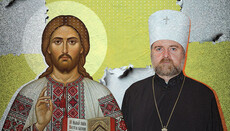
On the heresy of hating "foreign" enemies
20 December 14:56
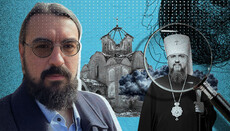
Interview for UOJ with a former OCU cleric – key takeaways
17 December 17:11
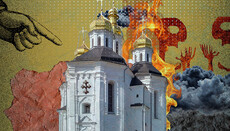
Broken windows theory: Why sharp polemics destroy the Church
12 December 17:25
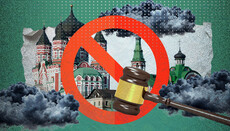
On the eve of the trial, or the UOC without Kyiv Metropolia
10 December 18:53

All will be persecuted: what did Apostle Paul mean?
07 December 14:44






